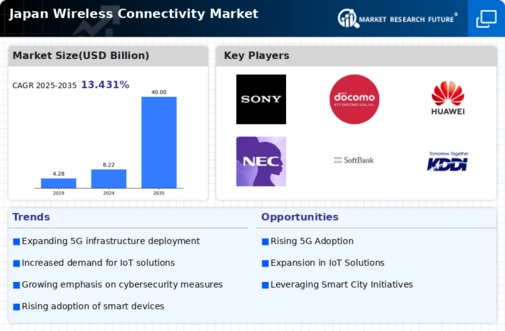Emergence of Smart Cities
The concept of smart cities is gaining traction in Japan, significantly influencing the wireless connectivity market. As urban areas evolve to incorporate smart technologies, the demand for seamless connectivity becomes increasingly critical. Smart city initiatives often involve the deployment of IoT devices, which require reliable wireless networks to function effectively. For example, cities like Tokyo are investing in smart traffic management systems that rely on real-time data transmission. This trend is expected to drive the wireless connectivity market as municipalities seek to enhance urban living through technology. Furthermore, the integration of smart solutions in public services is likely to create new opportunities for service providers, fostering innovation and competition within the market.
Government Initiatives and Support
The Japanese government plays a crucial role in shaping the wireless connectivity market through various initiatives aimed at enhancing digital infrastructure. Policies promoting the expansion of broadband access, particularly in rural areas, are indicative of the government's commitment to bridging the digital divide. For instance, the government has allocated approximately ¥1 trillion to improve connectivity across the nation, which is expected to bolster the wireless connectivity market significantly. Additionally, regulatory frameworks that encourage competition among service providers contribute to better service offerings and pricing for consumers. These government-backed efforts not only stimulate market growth but also ensure that Japan remains at the forefront of technological advancements in wireless connectivity.
Integration of Advanced Technologies
The integration of advanced technologies such as artificial intelligence (AI) and machine learning (ML) transforms the wireless connectivity market in Japan. These technologies enable more efficient network management and optimization, leading to improved service quality and user experience. For instance, AI-driven analytics can predict network congestion and automatically adjust resources to maintain optimal performance. This technological evolution is particularly relevant as the demand for seamless connectivity continues to rise. Moreover, the wireless connectivity market is projected to grow by approximately 15% annually, driven by these innovations. As businesses and consumers alike seek enhanced connectivity solutions, the adoption of AI and ML technologies is likely to become a key differentiator in the competitive landscape.
Rising Demand for High-Speed Internet
The wireless connectivity market in Japan experiences a notable surge in demand for high-speed internet services. As consumers increasingly rely on digital platforms for work, entertainment, and communication, the need for faster and more reliable internet connections becomes paramount. Recent data indicates that approximately 80% of households in urban areas have adopted high-speed internet, reflecting a shift in consumer behavior. This trend is further fueled by the proliferation of smart devices, which require robust connectivity to function optimally. Consequently, service providers are compelled to enhance their infrastructure to meet this growing demand, thereby driving investments in the wireless connectivity market. The emphasis on high-speed internet caters to both individual consumers and businesses seeking to improve operational efficiency through advanced connectivity solutions.
Shift Towards Remote Work and Learning
The ongoing shift towards remote work and learning in Japan has a profound impact on the wireless connectivity market. As organizations and educational institutions increasingly adopt flexible work arrangements, the demand for reliable and high-capacity wireless networks intensifies. Recent surveys indicate that over 60% of companies in Japan have implemented remote work policies, necessitating robust connectivity solutions to support their operations. This trend not only drives the need for enhanced wireless infrastructure but also encourages service providers to innovate and offer tailored solutions for remote connectivity. Consequently, the wireless connectivity market is likely to witness sustained growth as businesses and educational institutions invest in technologies that facilitate effective remote communication and collaboration.




















Leave a Comment